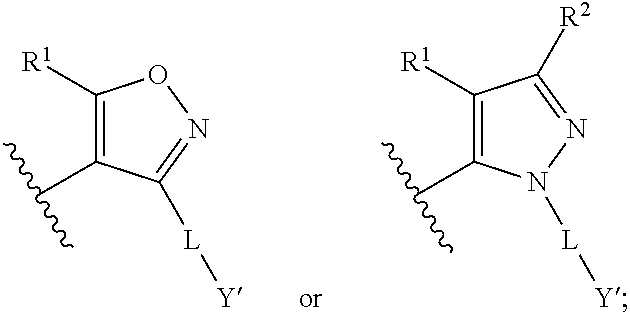Fxr (NR1H4) modulating compounds
a technology of fxr and modulating compounds, applied in the direction of drug compositions, extracellular fluid disorders, metabolic disorders, etc., can solve the problems of affecting the cellular differentiation, proliferation, or reproduction of cells, and the alteration of the genetic program involved in cellular differentiation, proliferation, or reproduction, etc., to achieve the effect of facilitating the development of a new type of cell
- Summary
- Abstract
- Description
- Claims
- Application Information
AI Technical Summary
Benefits of technology
Problems solved by technology
Method used
Image
Examples
example 1
hloro-4-((5-cyclopropyl-3-(3,5-dichloropyridin-4-yl)isoxazol-4-yl)methoxy)phenyl)-3-hydroxyazetidin-1-yl)nicotinic Acid
[0227]
Step 1: 3,5-dichloroisonicotinaldehyde Oxime
[0228]
[0229]3,5-dichloroisonicotinaldehyde oxime was synthesized analogously to procedures set forth in International Application Publication No. WO 2011 / 020615 starting with 3,5-dichloroisonicotinaldehyde.
Step 2: 3,5-dichloro-N-hydroxyisonicotinimidoyl chloride
[0230]
[0231]3,5-dichloro-N-hydroxyisonicotinimidoyl chloride was synthesized analogously to procedures set forth in International Application Publication No. WO 2011 / 020615 starting with 3,5-dichloroisonicotinaldehyde oxime.
Step 3: ethyl 5-cyclopropyl-3-(3,5-dichloropyridin-4-yl)isoxazole-4-carboxylate
[0232]
[0233]Ethyl 5-cyclopropyl-3-(3,5-dichloropyridin-4-yl)isoxazole-4-carboxylate was synthesized analogously to procedures set forth in International Application Publication No. WO 2011 / 020615 starting with 3,5-dichloro-N-hydroxyisonicotinimidoyl chloride.
Step...
example 2
hloro-4-((5-cyclopropyl-3-(2,6-dichlorophenyl)isoxazol-4-yl)methoxy)phenyl)-3-hydroxyazetidin-1-yl)nicotinic Acid
[0242]
Step 1: 6-(3-(2-chloro-4-((5-cyclopropyl-3-(2,6-dichlorophenyl)isoxazol-4-yl)methoxy)phenyl)-3-hydroxyazetidin-1-yl)nicotinonitrile
[0243]3-(2-chloro-4-((5-cyclopropyl-3-(2,6-dichlorophenyl)isoxazol-4-yl)methoxy)phenyl)azetidin-3-ol hydrochloride (3c, 500 mg, 1.07 mmol), 6-bromonicotinonitrile (295 mg, 1.61 mmol), potassium carbonate (666 mg, 10.7 mmol) and DMF (20 mL) were combined and heated at 80° C. for 45 minutes in a sealed tube. Water (20 mL) was added and the resulting mixture was extracted with EtOAc (50 mL×3), the combined organic phases were washed with brine (20 mL), dried over Na2SO4, filtered, and removed solvents in vacuo. Silica gel column chromatography gave the desired product.
Step 2: 6-(3-(2-chloro-4-((5-cyclopropyl-3-(2,6-dichlorophenyl)isoxazol-4-yl)methoxy)phenyl)-3-hydroxyazetidin-1-yl)nicotinic Acid (Example 2)
[0244]6-(3-(2-chloro-4-((5-cyclop...
example 3
hloro-4-((5-cyclopropyl-3-(2,6-dichlorophenyl)isoxazol-4-yl)methoxy)phenyl)-3-hydroxyazetidin-1-yl)-2-methylnicotinic Acid
[0245]
Step 1: 6-(3-(2-chloro-4-((5-cyclopropyl-3-(2,6-dichlorophenyl)isoxazol-4-yl)methoxy)phenyl)-3-hydroxyazetidin-1-yl)-2-methylnicotinonitrile
[0246]3-(2-chloro-4-((5-cyclopropyl-3-(2,6-dichlorophenyl)isoxazol-4-yl)methoxy)phenyl)azetidin-3-ol hydrochloride (3c, 200 mg, 0.40 mmol), 6-chloro-2-methylnicotinonitrile (73 mg, 0.47 mmol), potassium carbonate (247 mg, 4.0 mmol) and DMF (2 mL) were combined and the mixture was heated at 80° C. for 4 hrs in a sealed tube. Water (20 mL) was added and the resulting mixture was extracted with EtOAc (50 mL×3), the combined organic phases were washed with brine (20 mL), dried over Na2SO4, filtered, and removed solvents in vacuo. Silica gel column chromatography gave the desired product.
Step 2: 6-(3-(2-chloro-4-((5-cyclopropyl-3-(2,6-dichlorophenyl)isoxazol-4-yl)methoxy)phenyl)-3-hydroxyazetidin-1-yl)-2-methylnicotinic Acid...
PUM
| Property | Measurement | Unit |
|---|---|---|
| temperature | aaaaa | aaaaa |
| temperature | aaaaa | aaaaa |
| pH | aaaaa | aaaaa |
Abstract
Description
Claims
Application Information
 Login to View More
Login to View More - R&D
- Intellectual Property
- Life Sciences
- Materials
- Tech Scout
- Unparalleled Data Quality
- Higher Quality Content
- 60% Fewer Hallucinations
Browse by: Latest US Patents, China's latest patents, Technical Efficacy Thesaurus, Application Domain, Technology Topic, Popular Technical Reports.
© 2025 PatSnap. All rights reserved.Legal|Privacy policy|Modern Slavery Act Transparency Statement|Sitemap|About US| Contact US: help@patsnap.com



